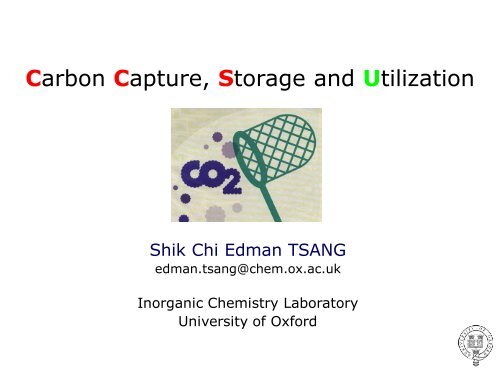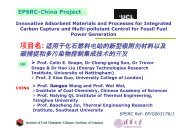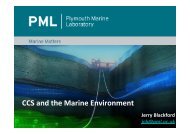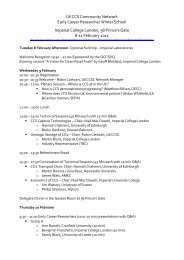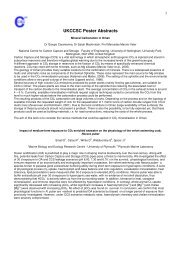You also want an ePaper? Increase the reach of your titles
YUMPU automatically turns print PDFs into web optimized ePapers that Google loves.
Carbon Capture, Storage and UtilizationShik Chi <strong>Edman</strong> TSANGedman.tsang@chem.ox.ac.ukInorganic Chemistry LaboratoryUniversity of Oxford
1. Why do we need CCS ?
Business as usual-total final consumptionSource: Shell 2006
Global carbon pools and fluxes. Modified from Lal (2008)
River Thames PictureRiver Thames= 3 x 10 15 g H 2 OLock Ness = 7.4 x 10 15 g H 2 O(10 times p.a.)(3 times p.a.)
2. The magnitude of CCSThe concept is to store carbon permanently and safely on theground at large scale. The storage needs to be maintained andthe responsibility for keeping the carbon out of the mobilecarbon pool for a long time.
Amine Scrubbing for CO 2 CaptureAmine scrubbing has beenused to separate carbondioxide (CO 2 ) from naturalgas and hydrogen since 1930.It is a robust technology andis ready to be tested andused on a larger scale for CO 2capture from coal-fired powerplants.Gary T. Rochelle, et al. Science, 325, 1652 (2009)
1. Inorganic PhysisorbentsAdsorbentsa. Zeolitesb. Activated carbons2.Chemisorbentsa. Metal-based adsorbentsb. Hydrotalcite-like compounds3. Organic and Organic–Inorganic Hybrid AdsorbentsAmines physically adsorbed onoxide supports; covalentlytethered to oxide supports; onsolid organic materials4. Metal–Organic Frameworks:An Emerging Class of Materials5. Ionic liquids
Precipitation-sublimation method:SiCl 4 diluted in pentane + NH 3 (g)Si x N y H z (MSIN-X)
Figure 1. (a) Typical TEM image of MSIN-673. (b) Nitrogen sorption isotherms for MSIN-673and its pore size distribution centred at 2.3 nm (insert).
Table 2 CO 2capture capacities of different materials at 1 bar but various temperaturesSamples Capacity (mmol g -1 ) Q st (kJ mol -1 ) Ref.298 K 373 KMSIN-673 2.6 2.3 68.1 This workAC 2.1 0.7 36.7 This workZeolite 13X 3.9 n.d. 34.4Cu-BTC 4.7 0.5 30.0MSIN-700 821 0.61 59.7
Figure 4. Cyclic tests of CO 2and N 2adsorptions on MSIN-673 at ambient temperature and pressure.
Synthesis of mesoporous Carbon nitridesScheme 1. For preparation of Mesoporous carbon nitrideVinnu. A. Adv. Funct. Mater. 2008, 18, 816.
CO 2 UtilisationsYu, Curcic, Gabriel, <strong>Tsang</strong> ChemSusChem. (2008), 1, 893.
The Chemical Fixation of CarbonHpolyols: sugars / glycerolepoxides2cyclic carbonatesCO / H 2 CO 2 / H 2Yu, Curcic, Gabriel, Morganstewart, <strong>Tsang</strong>, J. Phys. Chem. A, DOI: 10.1021/jp906365g
Carbon Recycle (CO 2 to Fuels)Making a liquid fuel from CO 2 will give us exciting opportunityto recycle the greenhouse gas to make the fuel that runs ourengines, producing energy, and provides the basic chemicalbuilding blocks that run our industries.(1) Catalytic fixing of CO 2 + renewable H 2 to hydrocarbons(2) Catalytic fixing of CO 2 + renewable H 2 to methanol(3) Photocatalytic fixing of CO 2 + renewable carriers tohydrocarbons/alcohols
Table 1. Catalytic activity comparison of different ZnO mixed with copper in the synthesis of methanol though thehydrogenation of CO 2Note: The reaction condition was fixed at 280 o C and 4.5MPa (CO 2/H 2volume ratio = 1:2.18) with 0.3gcatalysts (Cu/ZnO/Al 2O 3weight ratio = 1/1/1) in a tube micro-reactor. The detailed calculations of methanol selectivity andcarbon conversion were list in supporting information.CO 2+ 3H 2= CH 3 OH + H 2 OCatalyst CO 2 Conversion/% CH 3 OH Selectivity/%Rod ZnO/Cu/Al 2 O 3 15.3 39.1Plate ZnO/Cu/Al 2 O 3 12.0 71.6catalyticinterface:<strong>Tsang</strong> et al., Angew Chem, 2011, doi: 10.1002/anie.201007108.
Yu, Leung, <strong>Tsang</strong>, J. Am. Chem. Soc., 129(20) (2007), 6360 – 6361
6. Summary and Outlook•CCS can offer possible way to reduce CO 2 emission and has thepotential to offset years of accumulative CO 2 from atmosphere•Cost of CCS must be reduced (new chemistry, new materials,novel engineering and separation)•Lessons learned from small or large field projects will helpdeployment of CCS•Ambient CCS should be addressed•Recycling of carbon and utilization are more ideal than storage•Educate people to be more energy conscious
AcknowledgementsAbdullah Khan, Hongwei Yang, Dr Kerry Yu , Dr Connie Yeung, Dr Adam Kong, Dr.Valarie Caps, Dr Eric Yu, Dr Nick Cailuo, Dr William Oduro, Karaked Tedsree, Dr NadiaAcerbia (Oxford Chem)Tong Li, Dr. Paul Bagot, Prof. Angus Kirkland , Prof. George Smith (Oxford Materials)Drs Peter Bishop, Bene Thiebaut, James Cookson, David Thompsett , Janet Fischer andPaul Collier (Johnson Matthey)Dr Stan Glounski (Cardiff Univ.)Professor R Burch, Professor Chris Hardacre (QUB Univ.)Professor Heyong He, Prof. Xueqing Gong (Shanghai, China)


